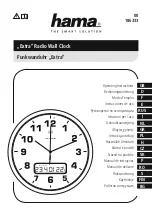
5
General information
The satellite receiver clock GPS163TDHS has been designed to provide an extremly
precise time reference for the generation of programmable pulses and IRIG/AFNOR-
codes.
The clock has been developed for applications where conventional radio controlled
clocks can´t meet the growing requirements in precision. High precision available 24
hours a day around the whole world is the main feature of the system which receives its
information from the satellites of the Global Positioning System.
The Global Positioning System (GPS) is a satellite-based radio-positioning, navigati-
on, and time-transfer system. It was installed by the United States Departement of
Defense and provides two levels of accuracy: The Standard Positioning Service (SPS)
and the Precise Positioning Service (PPS). While PPS is encrypted and only available for
authorized (military) users, SPS has been made available to the general public.
GPS is based on accurately measuring the propagation time of signals transmitted
from satellites to the user´s receiver. A nominal constellation of 21 satellites together with
3 active spares in six orbital planes 20000 km over ground provides a minimum of four
satellites to be in view 24 hours a day at every point of the globe. Four satellites need to
be received simultaneously if both receiver position (x, y, z) and receiver clock offset
from GPS system time must be computed. All the satellites are monitored by control
stations which determine the exact orbit parameters as well as the clock offset of the
satellites´ on-board atomic clocks. These parameters are uploaded to the satellites and
become part of a navigation message which is retransmitted by the satellites in order to
pass that information to the user´s receiver.
The high precision orbit parameters of a satellite are called ephemeris parameters
whereas a reduced precision subset of the ephemeris parameters is called a satellite´s
almanac. While ephemeris parameters must be evaluated to compute the receiver´s
position and clock offset, almanac parameters are used to check which satellites are in
view from a given receiver position at a given time. Each satellite transmits its own set of
ephemeris parameters and almanac parameters of all existing satellites.
Содержание GPS163TDHS
Страница 1: ...FUNKUHREN GPS163TDHS Technical Information Operating Instructions Incl Windows Software GPSMON32...
Страница 12: ...12 IRIG standard format x 3x TYPICAL MODULATED CARRIER IRIG A 10000 Hz IRIB B 1000 Hz binary 0 binary 1...
Страница 13: ...13 AFNOR time code format...
Страница 30: ...30...
Страница 31: ...31 Diskette with Windows Software GPSMON32...
Страница 34: ......





































